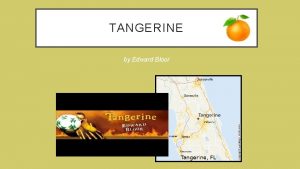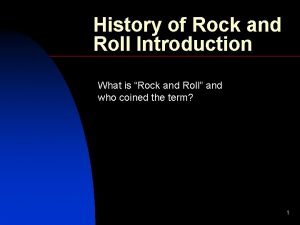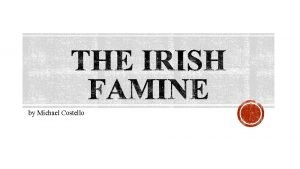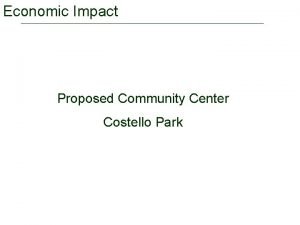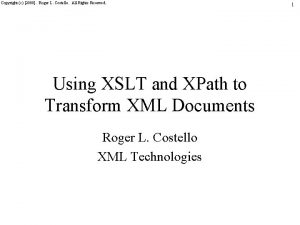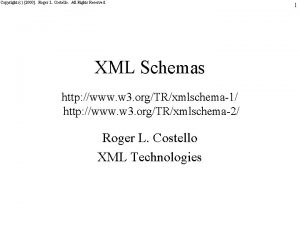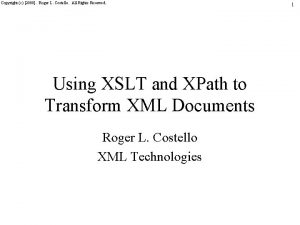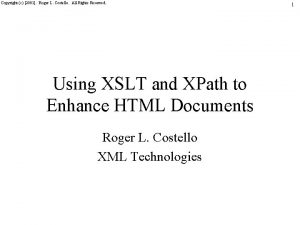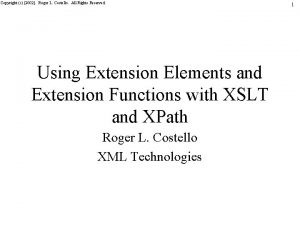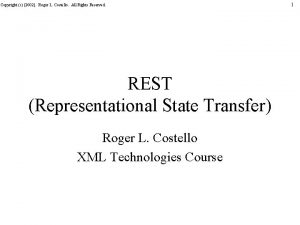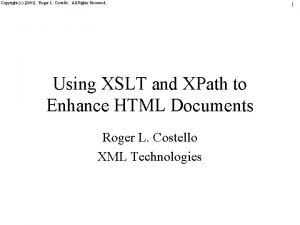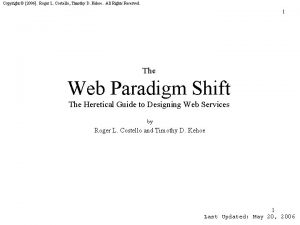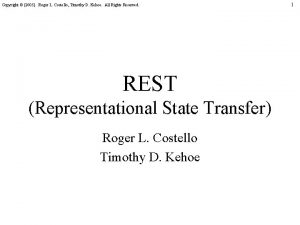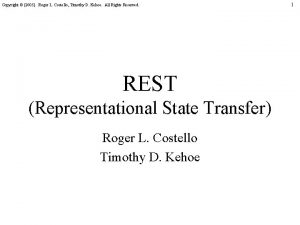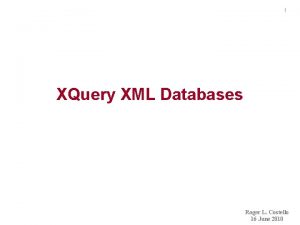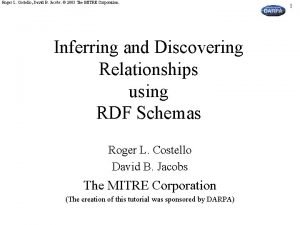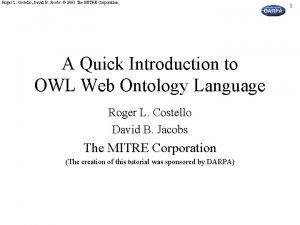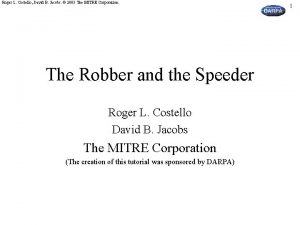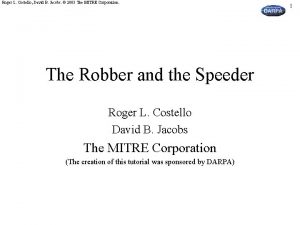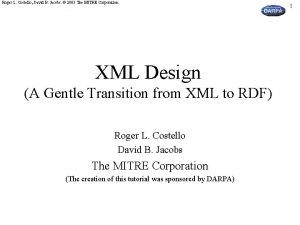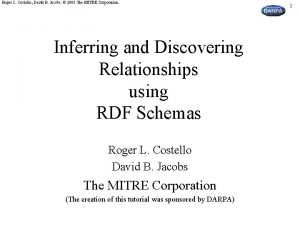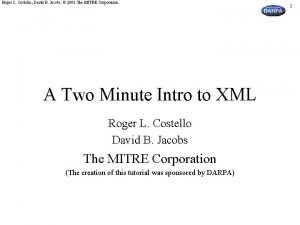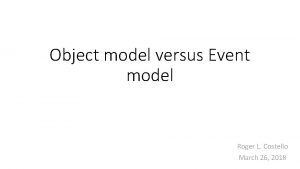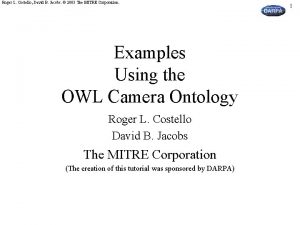Copyright c 2000 Roger L Costello All Rights
![Copyright (c) [2000]. Roger L. Costello. All Rights Reserved. Using XSLT and XPath to Copyright (c) [2000]. Roger L. Costello. All Rights Reserved. Using XSLT and XPath to](https://slidetodoc.com/presentation_image_h/200ad6e43a8cb4f9606c68342cfe765a/image-1.jpg)
![Copyright (c) [2000]. Roger L. Costello. All Rights Reserved. 2 Note • All the Copyright (c) [2000]. Roger L. Costello. All Rights Reserved. 2 Note • All the](https://slidetodoc.com/presentation_image_h/200ad6e43a8cb4f9606c68342cfe765a/image-2.jpg)
![Copyright (c) [2000]. Roger L. Costello. All Rights Reserved. 3 Transformation Language • XSL Copyright (c) [2000]. Roger L. Costello. All Rights Reserved. 3 Transformation Language • XSL](https://slidetodoc.com/presentation_image_h/200ad6e43a8cb4f9606c68342cfe765a/image-3.jpg)
![Copyright (c) [2000]. Roger L. Costello. All Rights Reserved. 4 Example: Filter Gold Members Copyright (c) [2000]. Roger L. Costello. All Rights Reserved. 4 Example: Filter Gold Members](https://slidetodoc.com/presentation_image_h/200ad6e43a8cb4f9606c68342cfe765a/image-4.jpg)
![Copyright (c) [2000]. Roger L. Costello. All Rights Reserved. XML Transformations - all about Copyright (c) [2000]. Roger L. Costello. All Rights Reserved. XML Transformations - all about](https://slidetodoc.com/presentation_image_h/200ad6e43a8cb4f9606c68342cfe765a/image-5.jpg)
![Copyright (c) [2000]. Roger L. Costello. All Rights Reserved. XML Transformations - all about Copyright (c) [2000]. Roger L. Costello. All Rights Reserved. XML Transformations - all about](https://slidetodoc.com/presentation_image_h/200ad6e43a8cb4f9606c68342cfe765a/image-6.jpg)
![Copyright (c) [2000]. Roger L. Costello. All Rights Reserved. XSL Document Structure <? xml Copyright (c) [2000]. Roger L. Costello. All Rights Reserved. XSL Document Structure <? xml](https://slidetodoc.com/presentation_image_h/200ad6e43a8cb4f9606c68342cfe765a/image-7.jpg)
![Copyright (c) [2000]. Roger L. Costello. All Rights Reserved. Template Rules Template rules take Copyright (c) [2000]. Roger L. Costello. All Rights Reserved. Template Rules Template rules take](https://slidetodoc.com/presentation_image_h/200ad6e43a8cb4f9606c68342cfe765a/image-8.jpg)
![Copyright (c) [2000]. Roger L. Costello. All Rights Reserved. Template Rules (Example) <xsl: template Copyright (c) [2000]. Roger L. Costello. All Rights Reserved. Template Rules (Example) <xsl: template](https://slidetodoc.com/presentation_image_h/200ad6e43a8cb4f9606c68342cfe765a/image-9.jpg)
![Copyright (c) [2000]. Roger L. Costello. All Rights Reserved. Terminology In Fitness. Center. xml Copyright (c) [2000]. Roger L. Costello. All Rights Reserved. Terminology In Fitness. Center. xml](https://slidetodoc.com/presentation_image_h/200ad6e43a8cb4f9606c68342cfe765a/image-10.jpg)
![Copyright (c) [2000]. Roger L. Costello. All Rights Reserved. 11 xsl: element • Suppose Copyright (c) [2000]. Roger L. Costello. All Rights Reserved. 11 xsl: element • Suppose](https://slidetodoc.com/presentation_image_h/200ad6e43a8cb4f9606c68342cfe765a/image-11.jpg)
![Copyright (c) [2000]. Roger L. Costello. All Rights Reserved. Identity Transformation • For our Copyright (c) [2000]. Roger L. Costello. All Rights Reserved. Identity Transformation • For our](https://slidetodoc.com/presentation_image_h/200ad6e43a8cb4f9606c68342cfe765a/image-12.jpg)
![Copyright (c) [2000]. Roger L. Costello. All Rights Reserved. 13 Document / PI <? Copyright (c) [2000]. Roger L. Costello. All Rights Reserved. 13 Document / PI <?](https://slidetodoc.com/presentation_image_h/200ad6e43a8cb4f9606c68342cfe765a/image-13.jpg)
![Copyright (c) [2000]. Roger L. Costello. All Rights Reserved. 14 <? xml version="1. 0"? Copyright (c) [2000]. Roger L. Costello. All Rights Reserved. 14 <? xml version="1. 0"?](https://slidetodoc.com/presentation_image_h/200ad6e43a8cb4f9606c68342cfe765a/image-14.jpg)
![Copyright (c) [2000]. Roger L. Costello. All Rights Reserved. <xsl: template match="Name"> <xsl: element Copyright (c) [2000]. Roger L. Costello. All Rights Reserved. <xsl: template match="Name"> <xsl: element](https://slidetodoc.com/presentation_image_h/200ad6e43a8cb4f9606c68342cfe765a/image-15.jpg)
![Copyright (c) [2000]. Roger L. Costello. All Rights Reserved. <? xml version="1. 0" encoding="UTF-8"? Copyright (c) [2000]. Roger L. Costello. All Rights Reserved. <? xml version="1. 0" encoding="UTF-8"?](https://slidetodoc.com/presentation_image_h/200ad6e43a8cb4f9606c68342cfe765a/image-16.jpg)
![Copyright (c) [2000]. Roger L. Costello. All Rights Reserved. 17 Getting Member’s Attribute: <xsl: Copyright (c) [2000]. Roger L. Costello. All Rights Reserved. 17 Getting Member’s Attribute: <xsl:](https://slidetodoc.com/presentation_image_h/200ad6e43a8cb4f9606c68342cfe765a/image-17.jpg)
![Copyright (c) [2000]. Roger L. Costello. All Rights Reserved. <? xml version="1. 0" encoding="UTF-8"? Copyright (c) [2000]. Roger L. Costello. All Rights Reserved. <? xml version="1. 0" encoding="UTF-8"?](https://slidetodoc.com/presentation_image_h/200ad6e43a8cb4f9606c68342cfe765a/image-18.jpg)
![Copyright (c) [2000]. Roger L. Costello. All Rights Reserved. 19 Generalize • Our identity Copyright (c) [2000]. Roger L. Costello. All Rights Reserved. 19 Generalize • Our identity](https://slidetodoc.com/presentation_image_h/200ad6e43a8cb4f9606c68342cfe765a/image-19.jpg)
![Copyright (c) [2000]. Roger L. Costello. All Rights Reserved. 20 <? xml version="1. 0"? Copyright (c) [2000]. Roger L. Costello. All Rights Reserved. 20 <? xml version="1. 0"?](https://slidetodoc.com/presentation_image_h/200ad6e43a8cb4f9606c68342cfe765a/image-20.jpg)
![Copyright (c) [2000]. Roger L. Costello. All Rights Reserved. 21 Default Template Rules • Copyright (c) [2000]. Roger L. Costello. All Rights Reserved. 21 Default Template Rules •](https://slidetodoc.com/presentation_image_h/200ad6e43a8cb4f9606c68342cfe765a/image-21.jpg)
![Copyright (c) [2000]. Roger L. Costello. All Rights Reserved. Multiple Applicable Rules Suppose that Copyright (c) [2000]. Roger L. Costello. All Rights Reserved. Multiple Applicable Rules Suppose that](https://slidetodoc.com/presentation_image_h/200ad6e43a8cb4f9606c68342cfe765a/image-22.jpg)
![Copyright (c) [2000]. Roger L. Costello. All Rights Reserved. Smallest Identity Transformation Stylesheet • Copyright (c) [2000]. Roger L. Costello. All Rights Reserved. Smallest Identity Transformation Stylesheet •](https://slidetodoc.com/presentation_image_h/200ad6e43a8cb4f9606c68342cfe765a/image-23.jpg)
![Copyright (c) [2000]. Roger L. Costello. All Rights Reserved. <? xml version="1. 0"? > Copyright (c) [2000]. Roger L. Costello. All Rights Reserved. <? xml version="1. 0"? >](https://slidetodoc.com/presentation_image_h/200ad6e43a8cb4f9606c68342cfe765a/image-24.jpg)
![Copyright (c) [2000]. Roger L. Costello. All Rights Reserved. <xsl: apply-templates select=“pattern”> • The Copyright (c) [2000]. Roger L. Costello. All Rights Reserved. <xsl: apply-templates select=“pattern”> • The](https://slidetodoc.com/presentation_image_h/200ad6e43a8cb4f9606c68342cfe765a/image-25.jpg)
![Copyright (c) [2000]. Roger L. Costello. All Rights Reserved. 26 <xsl: apply-templates select=“pattern”> <xsl: Copyright (c) [2000]. Roger L. Costello. All Rights Reserved. 26 <xsl: apply-templates select=“pattern”> <xsl:](https://slidetodoc.com/presentation_image_h/200ad6e43a8cb4f9606c68342cfe765a/image-26.jpg)
![Copyright (c) [2000]. Roger L. Costello. All Rights Reserved. Any Difference? <xsl: template match=“Fitness. Copyright (c) [2000]. Roger L. Costello. All Rights Reserved. Any Difference? <xsl: template match=“Fitness.](https://slidetodoc.com/presentation_image_h/200ad6e43a8cb4f9606c68342cfe765a/image-27.jpg)
![Copyright (c) [2000]. Roger L. Costello. All Rights Reserved. Can we use anything other Copyright (c) [2000]. Roger L. Costello. All Rights Reserved. Can we use anything other](https://slidetodoc.com/presentation_image_h/200ad6e43a8cb4f9606c68342cfe765a/image-28.jpg)
![Copyright (c) [2000]. Roger L. Costello. All Rights Reserved. 29 The XSL Vocabulary http: Copyright (c) [2000]. Roger L. Costello. All Rights Reserved. 29 The XSL Vocabulary http:](https://slidetodoc.com/presentation_image_h/200ad6e43a8cb4f9606c68342cfe765a/image-29.jpg)
![Copyright (c) [2000]. Roger L. Costello. All Rights Reserved. 30 Name of Prefix - Copyright (c) [2000]. Roger L. Costello. All Rights Reserved. 30 Name of Prefix -](https://slidetodoc.com/presentation_image_h/200ad6e43a8cb4f9606c68342cfe765a/image-30.jpg)
![Copyright (c) [2000]. Roger L. Costello. All Rights Reserved. mode Attribute • Allows you Copyright (c) [2000]. Roger L. Costello. All Rights Reserved. mode Attribute • Allows you](https://slidetodoc.com/presentation_image_h/200ad6e43a8cb4f9606c68342cfe765a/image-31.jpg)
![Copyright (c) [2000]. Roger L. Costello. All Rights Reserved. 32 Problem • Identity transform Copyright (c) [2000]. Roger L. Costello. All Rights Reserved. 32 Problem • Identity transform](https://slidetodoc.com/presentation_image_h/200ad6e43a8cb4f9606c68342cfe765a/image-32.jpg)
![Copyright (c) [2000]. Roger L. Costello. All Rights Reserved. <? xml version="1. 0" encoding="UTF-8"? Copyright (c) [2000]. Roger L. Costello. All Rights Reserved. <? xml version="1. 0" encoding="UTF-8"?](https://slidetodoc.com/presentation_image_h/200ad6e43a8cb4f9606c68342cfe765a/image-33.jpg)
![Copyright (c) [2000]. Roger L. Costello. All Rights Reserved. <? xml version="1. 0"? > Copyright (c) [2000]. Roger L. Costello. All Rights Reserved. <? xml version="1. 0"? >](https://slidetodoc.com/presentation_image_h/200ad6e43a8cb4f9606c68342cfe765a/image-34.jpg)
![Copyright (c) [2000]. Roger L. Costello. All Rights Reserved. 35 <xsl: template match="Name" mode="Normal"> Copyright (c) [2000]. Roger L. Costello. All Rights Reserved. 35 <xsl: template match="Name" mode="Normal">](https://slidetodoc.com/presentation_image_h/200ad6e43a8cb4f9606c68342cfe765a/image-35.jpg)
![Copyright (c) [2000]. Roger L. Costello. All Rights Reserved. Stylesheet Reuse via xsl: include Copyright (c) [2000]. Roger L. Costello. All Rights Reserved. Stylesheet Reuse via xsl: include](https://slidetodoc.com/presentation_image_h/200ad6e43a8cb4f9606c68342cfe765a/image-36.jpg)
![Copyright (c) [2000]. Roger L. Costello. All Rights Reserved. 37 <? xml version="1. 0"? Copyright (c) [2000]. Roger L. Costello. All Rights Reserved. 37 <? xml version="1. 0"?](https://slidetodoc.com/presentation_image_h/200ad6e43a8cb4f9606c68342cfe765a/image-37.jpg)
![Copyright (c) [2000]. Roger L. Costello. All Rights Reserved. 38 xsl: import • xsl: Copyright (c) [2000]. Roger L. Costello. All Rights Reserved. 38 xsl: import • xsl:](https://slidetodoc.com/presentation_image_h/200ad6e43a8cb4f9606c68342cfe765a/image-38.jpg)
![Copyright (c) [2000]. Roger L. Costello. All Rights Reserved. 39 Pipelining Stylesheets • Using Copyright (c) [2000]. Roger L. Costello. All Rights Reserved. 39 Pipelining Stylesheets • Using](https://slidetodoc.com/presentation_image_h/200ad6e43a8cb4f9606c68342cfe765a/image-39.jpg)
![Copyright (c) [2000]. Roger L. Costello. All Rights Reserved. xml-example 06 Here's how to Copyright (c) [2000]. Roger L. Costello. All Rights Reserved. xml-example 06 Here's how to](https://slidetodoc.com/presentation_image_h/200ad6e43a8cb4f9606c68342cfe765a/image-40.jpg)
- Slides: 40
![Copyright c 2000 Roger L Costello All Rights Reserved Using XSLT and XPath to Copyright (c) [2000]. Roger L. Costello. All Rights Reserved. Using XSLT and XPath to](https://slidetodoc.com/presentation_image_h/200ad6e43a8cb4f9606c68342cfe765a/image-1.jpg)
Copyright (c) [2000]. Roger L. Costello. All Rights Reserved. Using XSLT and XPath to Transform XML Documents Roger L. Costello XML Technologies 1
![Copyright c 2000 Roger L Costello All Rights Reserved 2 Note All the Copyright (c) [2000]. Roger L. Costello. All Rights Reserved. 2 Note • All the](https://slidetodoc.com/presentation_image_h/200ad6e43a8cb4f9606c68342cfe765a/image-2.jpg)
Copyright (c) [2000]. Roger L. Costello. All Rights Reserved. 2 Note • All the xsl functionality that we learned in creating XSL-enhanced HTML documents are applicable in transforming XML documents
![Copyright c 2000 Roger L Costello All Rights Reserved 3 Transformation Language XSL Copyright (c) [2000]. Roger L. Costello. All Rights Reserved. 3 Transformation Language • XSL](https://slidetodoc.com/presentation_image_h/200ad6e43a8cb4f9606c68342cfe765a/image-3.jpg)
Copyright (c) [2000]. Roger L. Costello. All Rights Reserved. 3 Transformation Language • XSL may be used as a transformation language --> it may be used to transform an XML document into another XML document (perhaps the new one is the same, minus company sensitive data) XSL XML Transformation Engine (XSL Processor) XML
![Copyright c 2000 Roger L Costello All Rights Reserved 4 Example Filter Gold Members Copyright (c) [2000]. Roger L. Costello. All Rights Reserved. 4 Example: Filter Gold Members](https://slidetodoc.com/presentation_image_h/200ad6e43a8cb4f9606c68342cfe765a/image-4.jpg)
Copyright (c) [2000]. Roger L. Costello. All Rights Reserved. 4 Example: Filter Gold Members <? xml version="1. 0"? > <Fitness. Center> <Member id="1" level="platinum"> <Name>Jeff</Name> <Phone type="home">555 -1234</Phone> <Phone type="work">555 -4321</Phone> <Favorite. Color>lightgrey</Favorite. Color> </Member> <Member id="2" level="gold"> <Name>David</Name> <Phone type="home">383 -1234</Phone> <Phone type="work">383 -4321</Phone> <Favorite. Color>lightblue</Favorite. Color> </Member> <Member id="3" level="platinum"> <Name>Roger</Name> <Phone type="home">888 -1234</Phone> <Phone type="work">888 -4321</Phone> <Favorite. Color>lightyellow</Favorite. Color> </Member> </Fitness. Center> <? xml version="1. 0"? > <Fitness. Center> <Member id="1" level="platinum"> <Name>Jeff</Name> <Phone type="home">555 -1234</Phone> <Phone type="work">555 -4321</Phone> <Favorite. Color>lightgrey</Favorite. Color> </Member> <Member id="3" level="platinum"> <Name>Roger</Name> <Phone type="home">888 -1234</Phone> <Phone type="work">888 -4321</Phone> <Favorite. Color>lightyellow</Favorite. Color> </Member> </Fitness. Center>
![Copyright c 2000 Roger L Costello All Rights Reserved XML Transformations all about Copyright (c) [2000]. Roger L. Costello. All Rights Reserved. XML Transformations - all about](https://slidetodoc.com/presentation_image_h/200ad6e43a8cb4f9606c68342cfe765a/image-5.jpg)
Copyright (c) [2000]. Roger L. Costello. All Rights Reserved. XML Transformations - all about (Template) “Rules” • “Hey xsl processor, when you encounter the root element (e. g. , Fitness. Center) do [action 1]” • “Hey xsl processor, when you encounter the Member element do [action 2]” • “Hey xsl processor, when you encounter the Name element do [action 3]” • And so forth 5
![Copyright c 2000 Roger L Costello All Rights Reserved XML Transformations all about Copyright (c) [2000]. Roger L. Costello. All Rights Reserved. XML Transformations - all about](https://slidetodoc.com/presentation_image_h/200ad6e43a8cb4f9606c68342cfe765a/image-6.jpg)
Copyright (c) [2000]. Roger L. Costello. All Rights Reserved. XML Transformations - all about (Template) “Rules” • Each template rule has two parts: – A pattern or matching part, that identifies the XML node in the source document to which the action part is to be applied. Matching information is contained in an attribute. – An action part that details the transformation of the node 6
![Copyright c 2000 Roger L Costello All Rights Reserved XSL Document Structure xml Copyright (c) [2000]. Roger L. Costello. All Rights Reserved. XSL Document Structure <? xml](https://slidetodoc.com/presentation_image_h/200ad6e43a8cb4f9606c68342cfe765a/image-7.jpg)
Copyright (c) [2000]. Roger L. Costello. All Rights Reserved. XSL Document Structure <? xml version=“ 1. 0”? > <xsl: stylesheet> <xsl: template match=“/”> [action] </xsl: template> <xsl: template match=“Fitness. Center”> [action] </xsl: template> <xsl: template match=“Member”> [action] </xsl: template>. . . </xsl: stylesheet> 7
![Copyright c 2000 Roger L Costello All Rights Reserved Template Rules Template rules take Copyright (c) [2000]. Roger L. Costello. All Rights Reserved. Template Rules Template rules take](https://slidetodoc.com/presentation_image_h/200ad6e43a8cb4f9606c68342cfe765a/image-8.jpg)
Copyright (c) [2000]. Roger L. Costello. All Rights Reserved. Template Rules Template rules take the following general form: <xsl: template match=“pattern”> [ action ] </xsl: template> 8
![Copyright c 2000 Roger L Costello All Rights Reserved Template Rules Example xsl template Copyright (c) [2000]. Roger L. Costello. All Rights Reserved. Template Rules (Example) <xsl: template](https://slidetodoc.com/presentation_image_h/200ad6e43a8cb4f9606c68342cfe765a/image-9.jpg)
Copyright (c) [2000]. Roger L. Costello. All Rights Reserved. Template Rules (Example) <xsl: template match=“Member”> <xsl: apply-templates/> </xsl: template> <xsl: template match=“Member”> “Hey XSL processor, as you parse through the XML document and you get to a <Member> element use this template rule. ” <xsl: apply-templates/> “Go to each of my children (the Member children) and apply the template rules to them. ” 9
![Copyright c 2000 Roger L Costello All Rights Reserved Terminology In Fitness Center xml Copyright (c) [2000]. Roger L. Costello. All Rights Reserved. Terminology In Fitness. Center. xml](https://slidetodoc.com/presentation_image_h/200ad6e43a8cb4f9606c68342cfe765a/image-10.jpg)
Copyright (c) [2000]. Roger L. Costello. All Rights Reserved. Terminology In Fitness. Center. xml we have (snippet): <Fitness. Center> <Member> <Name>Jeff</Name> <Phone type="home">555 -1234</Phone> <Phone type="work">555 -4321</Phone> <Favorite. Color>lightgrey</Favorite. Color> </Member>. . . </Fitness. Center> “Member is a child element of the Fitness. Center element. Name, Phone, and Favorite. Color are children elements of the Member element. Member is a parent of Name. Fitness. Center and Member are ancestors of Name. ” 10
![Copyright c 2000 Roger L Costello All Rights Reserved 11 xsl element Suppose Copyright (c) [2000]. Roger L. Costello. All Rights Reserved. 11 xsl: element • Suppose](https://slidetodoc.com/presentation_image_h/200ad6e43a8cb4f9606c68342cfe765a/image-11.jpg)
Copyright (c) [2000]. Roger L. Costello. All Rights Reserved. 11 xsl: element • Suppose that you are writing a stylesheet to generate an XML document. Obviously, you will need your stylesheet to output elements. – xsl: element is used to create elements <xsl: element name=“element-name”> [contents of the new element] </xsl: element> creates <element-name> [contents of the new element] </element-name>
![Copyright c 2000 Roger L Costello All Rights Reserved Identity Transformation For our Copyright (c) [2000]. Roger L. Costello. All Rights Reserved. Identity Transformation • For our](https://slidetodoc.com/presentation_image_h/200ad6e43a8cb4f9606c68342cfe765a/image-12.jpg)
Copyright (c) [2000]. Roger L. Costello. All Rights Reserved. Identity Transformation • For our first example, lets create a stylesheet which simply creates an XML document that is a copy of the input XML document 12
![Copyright c 2000 Roger L Costello All Rights Reserved 13 Document PI Copyright (c) [2000]. Roger L. Costello. All Rights Reserved. 13 Document / PI <?](https://slidetodoc.com/presentation_image_h/200ad6e43a8cb4f9606c68342cfe765a/image-13.jpg)
Copyright (c) [2000]. Roger L. Costello. All Rights Reserved. 13 Document / PI <? xml version=“ 1. 0”? > Element Fitness. Center . . . Element Member Element Name Text Jeff Element Member . . . Element Phone Element Favorite. Color Text 555 -1234 Text 555 -4321 Text lightgrey
![Copyright c 2000 Roger L Costello All Rights Reserved 14 xml version1 0 Copyright (c) [2000]. Roger L. Costello. All Rights Reserved. 14 <? xml version="1. 0"?](https://slidetodoc.com/presentation_image_h/200ad6e43a8cb4f9606c68342cfe765a/image-14.jpg)
Copyright (c) [2000]. Roger L. Costello. All Rights Reserved. 14 <? xml version="1. 0"? > <xsl: stylesheet xmlns: xsl="http: //www. w 3. org/1999/XSL/Transform" version="1. 0"> <xsl: output method="xml"/> <xsl: template match="/"> <xsl: apply-templates/> </xsl: template> <xsl: template match="Fitness. Center"> <xsl: element name="Fitness. Center"> <xsl: apply-templates/> </xsl: element> </xsl: template> <xsl: template match="Member"> <xsl: element name="Member"> <xsl: apply-templates/> </xsl: element> </xsl: template> Cont. -->
![Copyright c 2000 Roger L Costello All Rights Reserved xsl template matchName xsl element Copyright (c) [2000]. Roger L. Costello. All Rights Reserved. <xsl: template match="Name"> <xsl: element](https://slidetodoc.com/presentation_image_h/200ad6e43a8cb4f9606c68342cfe765a/image-15.jpg)
Copyright (c) [2000]. Roger L. Costello. All Rights Reserved. <xsl: template match="Name"> <xsl: element name="Name"> <xsl: apply-templates/> </xsl: element> </xsl: template> <xsl: template match="Phone"> <xsl: element name="Phone"> <xsl: apply-templates/> </xsl: element> </xsl: template> <xsl: template match="Favorite. Color"> <xsl: element name="Favorite. Color"> <xsl: apply-templates/> </xsl: element> </xsl: template> <xsl: template match="text()"> <xsl: value-of select=". "/> </xsl: template> </xsl: stylesheet> (see xml-example 01) 15
![Copyright c 2000 Roger L Costello All Rights Reserved xml version1 0 encodingUTF8 Copyright (c) [2000]. Roger L. Costello. All Rights Reserved. <? xml version="1. 0" encoding="UTF-8"?](https://slidetodoc.com/presentation_image_h/200ad6e43a8cb4f9606c68342cfe765a/image-16.jpg)
Copyright (c) [2000]. Roger L. Costello. All Rights Reserved. <? xml version="1. 0" encoding="UTF-8"? > <Fitness. Center> <Member> <Name>Jeff</Name> <Phone>555 -1234</Phone> <Phone>555 -4321</Phone> <Favorite. Color>lightgrey</Favorite. Color> </Member> <Name>David</Name> <Phone>383 -1234</Phone> <Phone>383 -4321</Phone> <Favorite. Color>lightblue</Favorite. Color> </Member> <Name>Roger</Name> <Phone>888 -1234</Phone> <Phone>888 -4321</Phone> <Favorite. Color>lightyellow</Favorite. Color> </Member> </Fitness. Center> Note that we've lost the attribute on the Member element 16
![Copyright c 2000 Roger L Costello All Rights Reserved 17 Getting Members Attribute xsl Copyright (c) [2000]. Roger L. Costello. All Rights Reserved. 17 Getting Member’s Attribute: <xsl:](https://slidetodoc.com/presentation_image_h/200ad6e43a8cb4f9606c68342cfe765a/image-17.jpg)
Copyright (c) [2000]. Roger L. Costello. All Rights Reserved. 17 Getting Member’s Attribute: <xsl: template match="Member"> <xsl: element name="Member"> <xsl: for-each select="@*"> <xsl: attribute name="{name(. )}"> <xsl: value-of select=". "/> </xsl: attribute> </xsl: for-each> <xsl: apply-templates/> </xsl: element> </xsl: template> (see xml-example 02) For each attribute Add an attribute to the element being output. The name of the attribute is the name of the current attribute being processed. The value of the attribute is the value of the current attribute being processed.
![Copyright c 2000 Roger L Costello All Rights Reserved xml version1 0 encodingUTF8 Copyright (c) [2000]. Roger L. Costello. All Rights Reserved. <? xml version="1. 0" encoding="UTF-8"?](https://slidetodoc.com/presentation_image_h/200ad6e43a8cb4f9606c68342cfe765a/image-18.jpg)
Copyright (c) [2000]. Roger L. Costello. All Rights Reserved. <? xml version="1. 0" encoding="UTF-8"? > <Fitness. Center> <Member level=“platinum”> <Name>Jeff</Name> <Phone type="home">555 -1234</Phone> <Phone type="work">555 -4321</Phone> <Favorite. Color>lightgrey</Favorite. Color> </Member> <Member level=“gold”> <Name>David</Name> <Phone type="home">383 -1234</Phone> <Phone type="work">383 -4321</Phone> <Favorite. Color>lightblue</Favorite. Color> </Member> <Member level=“platinum”> <Name>Roger</Name> <Phone type="home">888 -1234</Phone> <Phone type="work">888 -4321</Phone> <Favorite. Color>lightyellow</Favorite. Color> </Member> </Fitness. Center> 18
![Copyright c 2000 Roger L Costello All Rights Reserved 19 Generalize Our identity Copyright (c) [2000]. Roger L. Costello. All Rights Reserved. 19 Generalize • Our identity](https://slidetodoc.com/presentation_image_h/200ad6e43a8cb4f9606c68342cfe765a/image-19.jpg)
Copyright (c) [2000]. Roger L. Costello. All Rights Reserved. 19 Generalize • Our identity stylesheet will only work for Fitness. Center XML documents. We can make a stylesheet which does an identity transformation on any XML document.
![Copyright c 2000 Roger L Costello All Rights Reserved 20 xml version1 0 Copyright (c) [2000]. Roger L. Costello. All Rights Reserved. 20 <? xml version="1. 0"?](https://slidetodoc.com/presentation_image_h/200ad6e43a8cb4f9606c68342cfe765a/image-20.jpg)
Copyright (c) [2000]. Roger L. Costello. All Rights Reserved. 20 <? xml version="1. 0"? > <xsl: stylesheet xmlns: xsl="http: //www. w 3. org/1999/XSL/Transform" version="1. 0"> <xsl: output method="xml"/> <xsl: template match="/"> <xsl: apply-templates/> </xsl: template> <xsl: template match="*"> <xsl: element name="{name(. )}"> <xsl: for-each select="@*"> <xsl: attribute name="{name(. )}"> <xsl: value-of select=". "/> </xsl: attribute> </xsl: for-each> <xsl: apply-templates/> </xsl: element> </xsl: template> <xsl: template match="text()"> <xsl: value-of select=". "/> </xsl: template> </xsl: stylesheet> (see xml-example 03)
![Copyright c 2000 Roger L Costello All Rights Reserved 21 Default Template Rules Copyright (c) [2000]. Roger L. Costello. All Rights Reserved. 21 Default Template Rules •](https://slidetodoc.com/presentation_image_h/200ad6e43a8cb4f9606c68342cfe765a/image-21.jpg)
Copyright (c) [2000]. Roger L. Costello. All Rights Reserved. 21 Default Template Rules • Every xsl document has two default template rules • These rules are applied when the XSL Processor cannot find a template rule to use in your stylesheet • Here are the two default template rules: <xsl: template match=“/ | *”> <xsl: apply-templates/> </xsl: template> “Match on the document or any element. The action is to go to the children and execute their template rules. ” <xsl: template match=“text()”> “Match on a text node. The action <xsl: value-of select=“. ”/> is to output the value of the text node. ” </xsl: template>
![Copyright c 2000 Roger L Costello All Rights Reserved Multiple Applicable Rules Suppose that Copyright (c) [2000]. Roger L. Costello. All Rights Reserved. Multiple Applicable Rules Suppose that](https://slidetodoc.com/presentation_image_h/200ad6e43a8cb4f9606c68342cfe765a/image-22.jpg)
Copyright (c) [2000]. Roger L. Costello. All Rights Reserved. Multiple Applicable Rules Suppose that the XSL Processor is processing Fitness. Center and it gets to the <Member> element. Why does it use: <xsl: template match=“Member”>. . . and not the default template rule: <xsl: template match=“/ | *”>. . . ? ? ? After all, both apply. Answer: given two rules that apply, the more specific rule wins. --> Clearly, “*” is much more general than “Member”. “*” matches on any element. “Member” just matches on the Member element. 22
![Copyright c 2000 Roger L Costello All Rights Reserved Smallest Identity Transformation Stylesheet Copyright (c) [2000]. Roger L. Costello. All Rights Reserved. Smallest Identity Transformation Stylesheet •](https://slidetodoc.com/presentation_image_h/200ad6e43a8cb4f9606c68342cfe765a/image-23.jpg)
Copyright (c) [2000]. Roger L. Costello. All Rights Reserved. Smallest Identity Transformation Stylesheet • Now that we know about the default template rules, we can further reduce the size of the stylesheet. 23
![Copyright c 2000 Roger L Costello All Rights Reserved xml version1 0 Copyright (c) [2000]. Roger L. Costello. All Rights Reserved. <? xml version="1. 0"? >](https://slidetodoc.com/presentation_image_h/200ad6e43a8cb4f9606c68342cfe765a/image-24.jpg)
Copyright (c) [2000]. Roger L. Costello. All Rights Reserved. <? xml version="1. 0"? > <xsl: stylesheet xmlns: xsl="http: //www. w 3. org/1999/XSL/Transform" version="1. 0"> <xsl: output method="xml"/> <xsl: template match="*"> <xsl: element name="{name(. )}"> <xsl: for-each select="@*"> <xsl: attribute name="{name(. )}"> <xsl: value-of select=". "/> </xsl: attribute> </xsl: for-each> <xsl: apply-templates/> </xsl: element> </xsl: template> </xsl: stylesheet> (see xml-example 04) 24
![Copyright c 2000 Roger L Costello All Rights Reserved xsl applytemplates selectpattern The Copyright (c) [2000]. Roger L. Costello. All Rights Reserved. <xsl: apply-templates select=“pattern”> • The](https://slidetodoc.com/presentation_image_h/200ad6e43a8cb4f9606c68342cfe765a/image-25.jpg)
Copyright (c) [2000]. Roger L. Costello. All Rights Reserved. <xsl: apply-templates select=“pattern”> • The xsl: apply-templates element (without the select attribute) tells the XSL Processor to apply the template rules to all children (in document order) • The xsl: apply-templates element can have a select attribute that tells the XSL Processor to process only the child element that matches “pattern”. – Thus, the select attribute rule enables us to specify the order in which the children are processed 25
![Copyright c 2000 Roger L Costello All Rights Reserved 26 xsl applytemplates selectpattern xsl Copyright (c) [2000]. Roger L. Costello. All Rights Reserved. 26 <xsl: apply-templates select=“pattern”> <xsl:](https://slidetodoc.com/presentation_image_h/200ad6e43a8cb4f9606c68342cfe765a/image-26.jpg)
Copyright (c) [2000]. Roger L. Costello. All Rights Reserved. 26 <xsl: apply-templates select=“pattern”> <xsl: template match="Member"> <xsl: apply-templates select="Name"/> <xsl: apply-templates select="Phone[@type='work']"/> </xsl: template> "Go to the template rule for my Name child element. Then go to the template rule for the work Phone child element. " <xsl: template match="Member"> <xsl: apply-templates select="*"/> </xsl: template> "Go to all the child element nodes (not to any child text nodes). " Do Lab 4, Part 1 -4
![Copyright c 2000 Roger L Costello All Rights Reserved Any Difference xsl template matchFitness Copyright (c) [2000]. Roger L. Costello. All Rights Reserved. Any Difference? <xsl: template match=“Fitness.](https://slidetodoc.com/presentation_image_h/200ad6e43a8cb4f9606c68342cfe765a/image-27.jpg)
Copyright (c) [2000]. Roger L. Costello. All Rights Reserved. Any Difference? <xsl: template match=“Fitness. Center”> <xsl: element name=“{name(. )}”> <xsl: apply-templates/> </xsl: element> </xsl: template> <xsl: template match=“Fitness. Center”> <xsl: element name=“Fitness. Center”> <xsl: apply-templates/> </xsl: element> </xsl: template> <xsl: template match=“Fitness. Center”> <Fitness. Center> <xsl: apply-templates/> </Fitness. Center> </xsl: template> 27
![Copyright c 2000 Roger L Costello All Rights Reserved Can we use anything other Copyright (c) [2000]. Roger L. Costello. All Rights Reserved. Can we use anything other](https://slidetodoc.com/presentation_image_h/200ad6e43a8cb4f9606c68342cfe765a/image-28.jpg)
Copyright (c) [2000]. Roger L. Costello. All Rights Reserved. Can we use anything other that name(. )? <xsl: template match="*"> <xsl: element name="{name(. )}"> <xsl: for-each select="@*"> <xsl: attribute name="{name(. )}"> <xsl: value-of select=". "/> </xsl: attribute> </xsl: for-each> <xsl: apply-templates/> </xsl: element> </xsl: template> 28
![Copyright c 2000 Roger L Costello All Rights Reserved 29 The XSL Vocabulary http Copyright (c) [2000]. Roger L. Costello. All Rights Reserved. 29 The XSL Vocabulary http:](https://slidetodoc.com/presentation_image_h/200ad6e43a8cb4f9606c68342cfe765a/image-29.jpg)
Copyright (c) [2000]. Roger L. Costello. All Rights Reserved. 29 The XSL Vocabulary http: //www. w 3. org/1999/XSL/Transform stylesheet if choose for-each apply-templates xsl: value-of template An XSL Processor is a piece of software which understands the semantics of this vocabulary
![Copyright c 2000 Roger L Costello All Rights Reserved 30 Name of Prefix Copyright (c) [2000]. Roger L. Costello. All Rights Reserved. 30 Name of Prefix -](https://slidetodoc.com/presentation_image_h/200ad6e43a8cb4f9606c68342cfe765a/image-30.jpg)
Copyright (c) [2000]. Roger L. Costello. All Rights Reserved. 30 Name of Prefix - Irrelevant! http: //www. w 3. org/1999/XSL/Transform stylesheet We can call this anything we want if choose for-each apply-templates xsl: value-of template
![Copyright c 2000 Roger L Costello All Rights Reserved mode Attribute Allows you Copyright (c) [2000]. Roger L. Costello. All Rights Reserved. mode Attribute • Allows you](https://slidetodoc.com/presentation_image_h/200ad6e43a8cb4f9606c68342cfe765a/image-31.jpg)
Copyright (c) [2000]. Roger L. Costello. All Rights Reserved. mode Attribute • Allows you to create multiple template rules for the same element. Each template rule can process the element differently. • So, you can have multiple template rules for the same element. Just give each template rule a different mode <xsl: template match="Name" mode="Normal"> <xsl: template match="Name" mode="footnote"> 31
![Copyright c 2000 Roger L Costello All Rights Reserved 32 Problem Identity transform Copyright (c) [2000]. Roger L. Costello. All Rights Reserved. 32 Problem • Identity transform](https://slidetodoc.com/presentation_image_h/200ad6e43a8cb4f9606c68342cfe765a/image-32.jpg)
Copyright (c) [2000]. Roger L. Costello. All Rights Reserved. 32 Problem • Identity transform the Fitness. Center. xml document. However, after you have copied all the Members, follow up with a (new) Gold. Members section, containing the name of each gold member (within stars) • The next slide shows what the output XML file should look like
![Copyright c 2000 Roger L Costello All Rights Reserved xml version1 0 encodingUTF8 Copyright (c) [2000]. Roger L. Costello. All Rights Reserved. <? xml version="1. 0" encoding="UTF-8"?](https://slidetodoc.com/presentation_image_h/200ad6e43a8cb4f9606c68342cfe765a/image-33.jpg)
Copyright (c) [2000]. Roger L. Costello. All Rights Reserved. <? xml version="1. 0" encoding="UTF-8"? > <Fitness. Center> <Member level="platinum"> <Name>Jeff</Name> <Phone>555 -1234</Phone> <Phone>555 -4321</Phone> <Favorite. Color>lightgrey</Favorite. Color> </Member> <Member level="gold"> <Name>David</Name> <Phone>383 -1234</Phone> <Phone>383 -4321</Phone> <Favorite. Color>lightblue</Favorite. Color> </Member> <Member level="platinum"> <Name>Roger</Name> <Phone>888 -1234</Phone> <Phone>888 -4321</Phone> <Favorite. Color>lightyellow</Favorite. Color> </Member> <Gold. Members> <Name>***David***</Name> </Gold. Members> </Fitness. Center> (see xml-example 05) 33 Note that the names here are processed differently than the name in the Gold. Members section
![Copyright c 2000 Roger L Costello All Rights Reserved xml version1 0 Copyright (c) [2000]. Roger L. Costello. All Rights Reserved. <? xml version="1. 0"? >](https://slidetodoc.com/presentation_image_h/200ad6e43a8cb4f9606c68342cfe765a/image-34.jpg)
Copyright (c) [2000]. Roger L. Costello. All Rights Reserved. <? xml version="1. 0"? > <xsl: stylesheet xmlns: xsl="http: //www. w 3. org/1999/XSL/Transform" version="1. 0"> <xsl: output method="xml"/> <xsl: template match="/"> <xsl: apply-templates/> </xsl: template> <xsl: template match="Fitness. Center"> <xsl: element name="Fitness. Center"> <xsl: apply-templates/> <xsl: element name="Gold. Members"> <xsl: for-each select="Member[@level='gold']"> <xsl: apply-templates select="Name" mode="footnote"/> </xsl: for-each> </xsl: element> </xsl: template> <xsl: template match="Member"> <xsl: element name="Member"> <xsl: for-each select="@*"> <xsl: attribute name="{name(. )}"> <xsl: value-of select=". "/> </xsl: attribute> </xsl: for-each> <xsl: apply-templates mode="Normal"/> </xsl: element> </xsl: template> 34
![Copyright c 2000 Roger L Costello All Rights Reserved 35 xsl template matchName modeNormal Copyright (c) [2000]. Roger L. Costello. All Rights Reserved. 35 <xsl: template match="Name" mode="Normal">](https://slidetodoc.com/presentation_image_h/200ad6e43a8cb4f9606c68342cfe765a/image-35.jpg)
Copyright (c) [2000]. Roger L. Costello. All Rights Reserved. 35 <xsl: template match="Name" mode="Normal"> <xsl: element name="Name"> <xsl: apply-templates/> </xsl: element> </xsl: template> <xsl: template match="Name" mode="footnote"> <xsl: element name="Name"> <xsl: text>***</xsl: text> <xsl: apply-templates/> <xsl: text>***</xsl: text> </xsl: element> </xsl: template> <xsl: template match="Phone" mode="Normal"> <xsl: element name="Phone"> <xsl: apply-templates/> </xsl: element> </xsl: template> <xsl: template match="Favorite. Color" mode="Normal"> <xsl: element name="Favorite. Color"> <xsl: apply-templates/> </xsl: element> </xsl: template> </xsl: stylesheet> Do Lab 5, Part 1
![Copyright c 2000 Roger L Costello All Rights Reserved Stylesheet Reuse via xsl include Copyright (c) [2000]. Roger L. Costello. All Rights Reserved. Stylesheet Reuse via xsl: include](https://slidetodoc.com/presentation_image_h/200ad6e43a8cb4f9606c68342cfe765a/image-36.jpg)
Copyright (c) [2000]. Roger L. Costello. All Rights Reserved. Stylesheet Reuse via xsl: include and xsl: import • The elements xsl: include and xsl: import enable you to reuse other stylesheets. • These elements are “top-level elements”. This means that they must be immediate children of the xsl: stylesheet element (i. e. , they cannot be within a template rule) • The xsl: include element is basically a macro substitution the element is replaced by the contents of stylesheet it references 36
![Copyright c 2000 Roger L Costello All Rights Reserved 37 xml version1 0 Copyright (c) [2000]. Roger L. Costello. All Rights Reserved. 37 <? xml version="1. 0"?](https://slidetodoc.com/presentation_image_h/200ad6e43a8cb4f9606c68342cfe765a/image-37.jpg)
Copyright (c) [2000]. Roger L. Costello. All Rights Reserved. 37 <? xml version="1. 0"? > <xsl: stylesheet xmlns: xsl="http: //www. w 3. org/1999/XSL/Transform" version="1. 0"> <xsl: include href="file: //localhost/xml-course/new-xsl/to. Upper. Case. xsl"/> <xsl: template match="Fitness. Center">. . . </xsl: template>. . . </xsl: stylesheet> Replace the xsl: include element with the contents of the referenced stylesheet (i. e. , all the children of xsl: stylesheet) <? xml version="1. 0"? > <xsl: stylesheet xmlns: xsl="http: //www. w 3. org/1999/XSL/Transform" version="1. 0"> <xsl: variable name="lcase" select="'abcdefghijklmnopqrstuvwxyz'"/> <xsl: variable name="ucase" select="'ABCDEFGHIJKLMNOPQRSTUVWXYZ'"/> <xsl: template match="*"> <xsl: apply-templates select="@* | text() | comment() | processing-instruction()"/> </xsl: template> <xsl: template match="@*"> <xsl: value-of select="translate(. , $lcase, $ucase)"/> </xsl: template> <xsl: template match="text()"> <xsl: value-of select="translate(. , $lcase, $ucase)"/> </xsl: template> </xsl: stylesheet> to. Upper. Case. xsl
![Copyright c 2000 Roger L Costello All Rights Reserved 38 xsl import xsl Copyright (c) [2000]. Roger L. Costello. All Rights Reserved. 38 xsl: import • xsl:](https://slidetodoc.com/presentation_image_h/200ad6e43a8cb4f9606c68342cfe765a/image-38.jpg)
Copyright (c) [2000]. Roger L. Costello. All Rights Reserved. 38 xsl: import • xsl: import acts just like xsl: include - the stylesheet that it references is macro-substituted. However, there is a difference: – With xsl: include the stuff that is macro-substituted into the stylesheet has the same precedence as the rest of the stylesheet. It is as though you had one stylesheet. – With xsl: import the stuff that is macro-substituted into the stylesheet has lower precedence than the rest of the stylesheet. Also, all xsl: import elements must come first in the stylesheet.
![Copyright c 2000 Roger L Costello All Rights Reserved 39 Pipelining Stylesheets Using Copyright (c) [2000]. Roger L. Costello. All Rights Reserved. 39 Pipelining Stylesheets • Using](https://slidetodoc.com/presentation_image_h/200ad6e43a8cb4f9606c68342cfe765a/image-39.jpg)
Copyright (c) [2000]. Roger L. Costello. All Rights Reserved. 39 Pipelining Stylesheets • Using the XSL API (TRa. X - Transformation API for XML) I have created a program which enables you to have a pipeline of stylesheets, i. e. , the output of stylesheet[i] is the input to stylesheet[i+1] Example: XML XSL Fitness. Center. xml generate. Name. List. xsl to. Upper. Case. xsl List of Member names, in upper case! See xml-example 06. Type this at the DOS prompt: run-xalan Fitness. Center. xml generate. Name. List. xsl to. Upper. Case. xsl
![Copyright c 2000 Roger L Costello All Rights Reserved xmlexample 06 Heres how to Copyright (c) [2000]. Roger L. Costello. All Rights Reserved. xml-example 06 Here's how to](https://slidetodoc.com/presentation_image_h/200ad6e43a8cb4f9606c68342cfe765a/image-40.jpg)
Copyright (c) [2000]. Roger L. Costello. All Rights Reserved. xml-example 06 Here's how to use the program that I created: run-xalan <xml file> <xsl file> … <xsl file> That is, you can specify any number of xsl files to be used in the pipeline. 40
 Copyright 2015 all rights reserved
Copyright 2015 all rights reserved Copyright 2015 all rights reserved
Copyright 2015 all rights reserved Dell all rights reserved copyright 2009
Dell all rights reserved copyright 2009 Copyright © 2018 all rights reserved
Copyright © 2018 all rights reserved Methadone clinic durango co
Methadone clinic durango co Characters in tangerine by edward bloor
Characters in tangerine by edward bloor Rock and roll nnn
Rock and roll nnn Philippa costello
Philippa costello Costello landscaping
Costello landscaping Michael costello ireland
Michael costello ireland Dianne costello
Dianne costello Costello park
Costello park Positive rights vs negative rights
Positive rights vs negative rights Riparian vs littoral rights
Riparian vs littoral rights Characteristics of rights
Characteristics of rights Legal rights and moral rights
Legal rights and moral rights Negative rights vs positive rights
Negative rights vs positive rights Negative rights
Negative rights Negative rights vs positive rights
Negative rights vs positive rights Positive rights and negative rights
Positive rights and negative rights Opposite rays
Opposite rays Education for all 2000-2015: achievements and challenges
Education for all 2000-2015: achievements and challenges All rights reserved example
All rights reserved example All rights reserved sentence
All rights reserved sentence Freesound content licence
Freesound content licence Confidential all rights reserved
Confidential all rights reserved Sentinel repetition
Sentinel repetition Pearson education inc all rights reserved
Pearson education inc all rights reserved Microsoft corporation. all rights reserved.
Microsoft corporation. all rights reserved. Microsoft corporation. all rights reserved
Microsoft corporation. all rights reserved Microsoft corporation. all rights reserved.
Microsoft corporation. all rights reserved. Pearson education inc. all rights reserved
Pearson education inc. all rights reserved Warning all rights reserved
Warning all rights reserved Siprop
Siprop All rights reserved formula
All rights reserved formula Warning all rights reserved
Warning all rights reserved Confidential all rights reserved
Confidential all rights reserved Microsoft corporation. all rights reserved
Microsoft corporation. all rights reserved 2010 pearson education inc
2010 pearson education inc 2017 all rights reserved
2017 all rights reserved Pearson education inc all rights reserved
Pearson education inc all rights reserved





